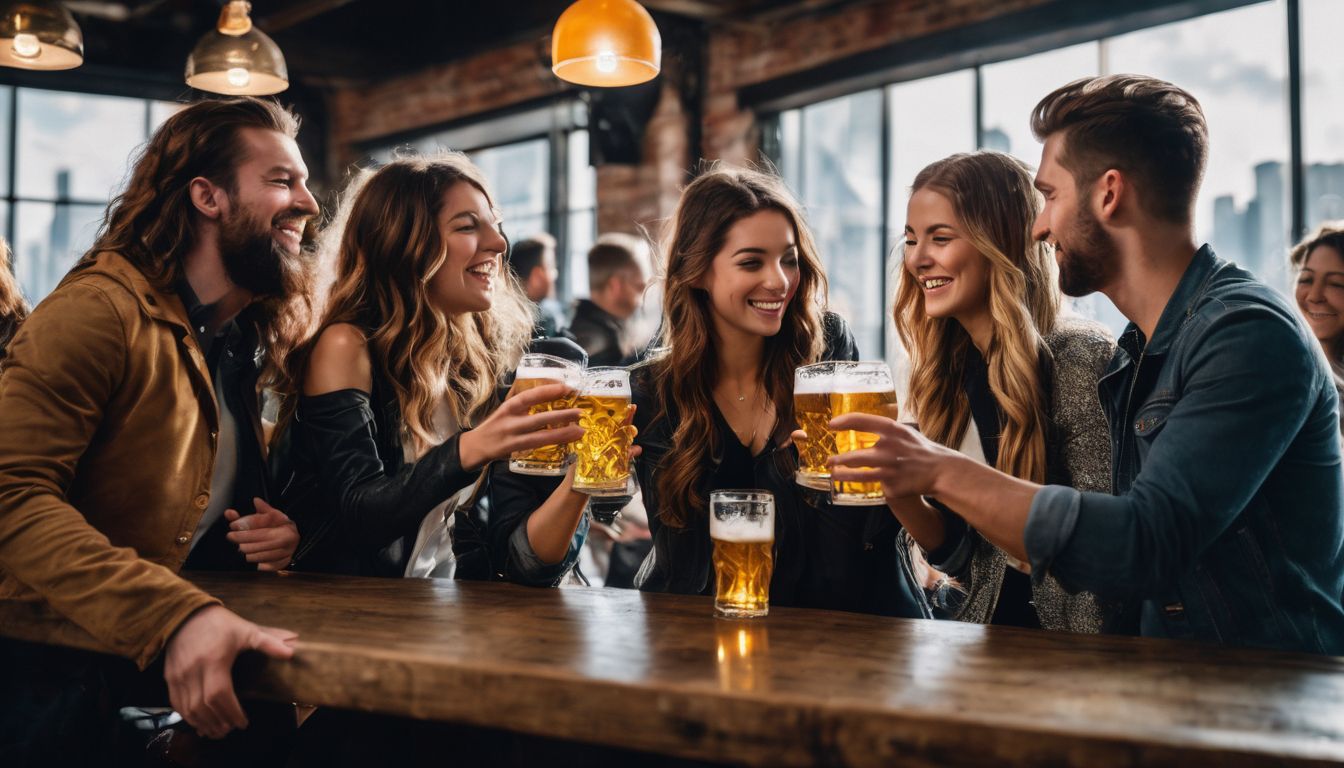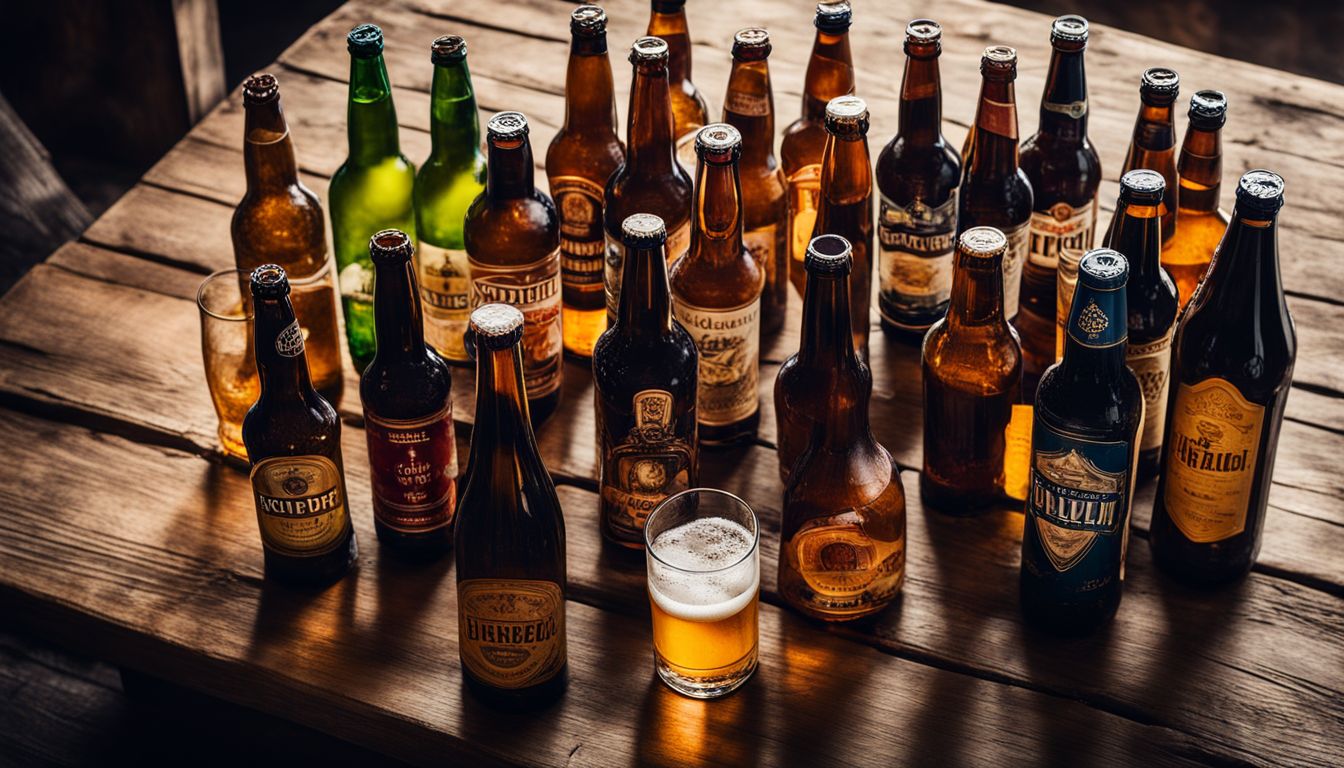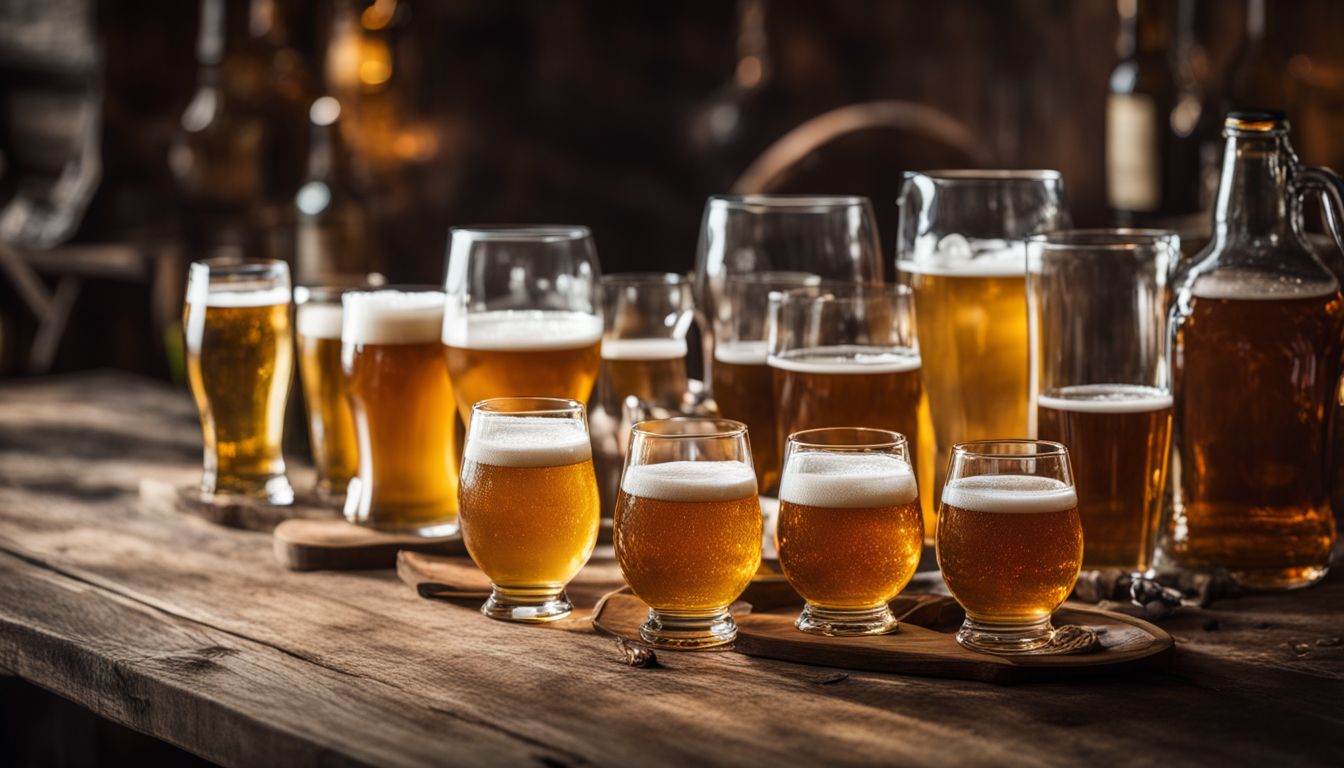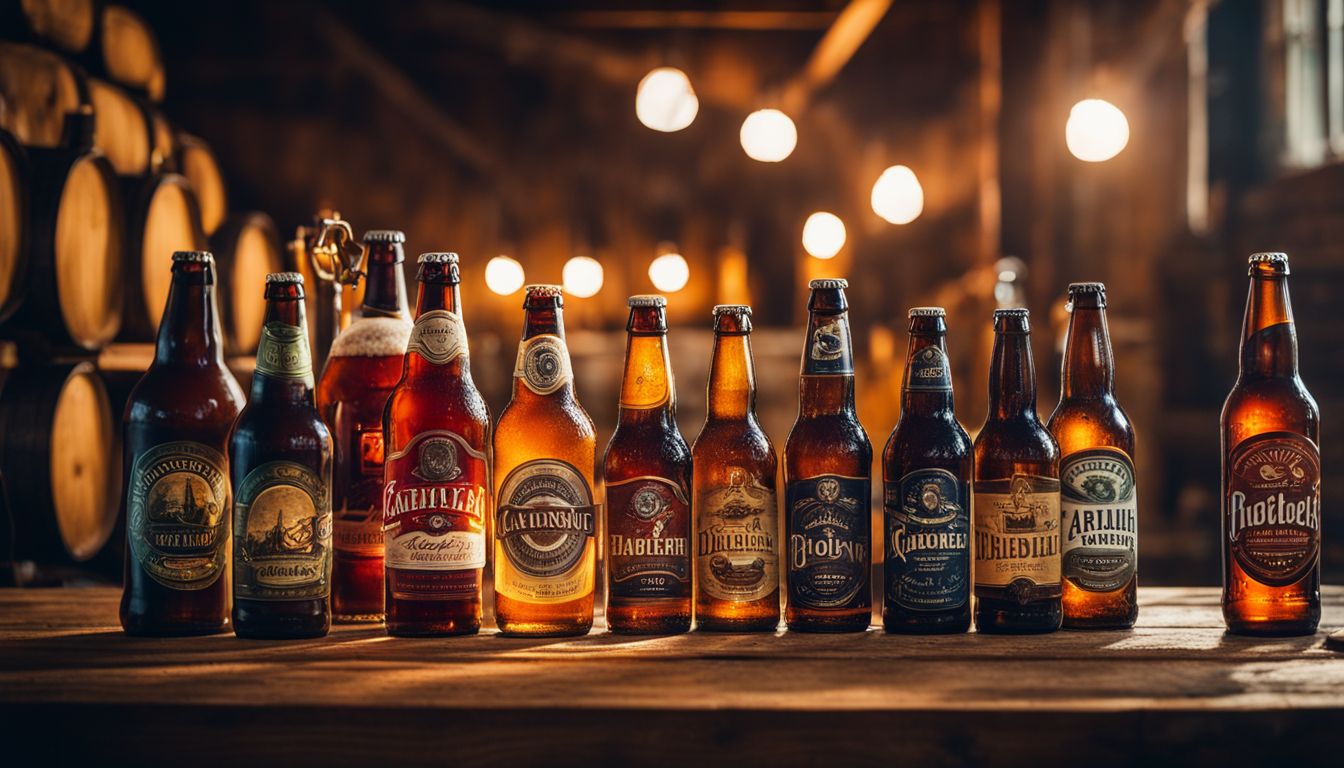Are you a beer lover keen to deepen your appreciation for this time-honoured drink? Beer tasting is an art form, with the fine details and subtle notes often overlooked. This article will guide you through the world of beer tasting, giving insider tips on how to elevate your enjoyment from a mere drinker to an informed connoisseur.
Let’s embark on this frothy journey!
Key Takeaways
- Beer tasting involves four steps: looking at the beer’s appearance, smelling its aroma, taking a small sip to taste its notes, and reflecting on the flavors after each sip.
- Understanding common flavor components in beer, such as hoppy bitterness and malt sweetness, can enhance your appreciation of different beers.
- Choosing the right glassware, controlling the temperature when serving beer, and mastering pouring techniques all contribute to an enhanced beer tasting experience.
Understanding the Basics of Beer Tasting

The four steps of beer tasting are essential to fully appreciate the complex flavors and aromas present in different beers.
The Four Steps of Beer Tasting

Beer tasting has four key steps.
- You need to look at the beer first. See its colour and check how clear it is.
- Sniff the beer next. This helps you pick up on its smells.
- Now, take a small sip of the beer. Try to taste all of its different notes.
- Lastly, think about what you tasted after each sip.
Common Flavor Components in Beer

Beer is a delicious and complex beverage, with many different flavors to explore. When tasting beer, it’s important to pay attention to the common flavor components that you might encounter.
One of these components is hoppy bitterness, which can be tasted at the back of your tongue. Another component is malt sweetness, which adds a rich and caramel-like taste. You might also notice fruity or citrusy flavors from the yeast used in brewing.
And let’s not forget about the carbonation, which gives beer its refreshing fizziness. Understanding these common flavor components will help you appreciate and enjoy beer even more!
Beer Styles and Tasting Notes

Beer tasting takes into account the different styles of beer and their respective tasting notes. Each style of beer possesses unique characteristics, flavours, and aromas that contribute to its overall profile.
| Beer Style | Tasting Notes |
|---|---|
| Ale | Ales are known for their robust flavour and strength. They often have fruity and spicy notes due to the yeast fermentation process. |
| Lager | Lagers are crisp and clean in their taste. Their characteristic notes are malt sweetness with a hint of bitterness from hops. |
| Stout | Stouts are known for their dark, rich and robust character. They often have notes of chocolate, coffee, and sometimes a smoky flavour. |
| IPA (India Pale Ale) | IPAs are popular for their intense hop bitterness. They carry notes of citrus, floral, pine, and tropical fruits. |
| Wheat Beer | Wheat beers offer a light, fruity and slightly tart taste. They often have notes of banana, clove, and sometimes vanilla. |
| Porter | Porters are known for their dark and complex flavours. They carry notes of chocolate, coffee, caramel, and sometimes a smoky touch. |
Understanding these styles and tasting notes will enhance your beer appreciation and help you develop a well-rounded palate. It is also important to remember that slowing down, recognising these notes, and building a vocabulary to describe them is vital for proper tasting.
Enhancing the Beer Tasting Experience

Improve your beer tasting experience by using the right glassware, controlling the temperature, and mastering pouring techniques.
The Importance of Glassware in Beer Tasting

To truly appreciate the flavors and aromas of beer, choosing the right glassware is essential. Different styles of beer have unique characteristics that can be enhanced or diminished by the shape and design of the glass.
For example, tulip glasses are perfect for capturing delicate aromas, while pint glasses allow for easy sipping and enjoyment. The right glassware can also help to maintain proper temperature and carbonation levels.
So next time you pour yourself a craft brew, take a moment to consider the glass you’re using – it could make all the difference in your beer tasting experience.
Temperature Control

To fully appreciate the flavors and aromas of beer, temperature control is essential. Serving your beer at the right temperature can make a big difference in its taste. When beer is too cold, it can mask some of its flavors and aromas.
On the other hand, when it’s too warm, it may taste flat or even unpleasant.
Different styles of beer have different optimal serving temperatures, but as a general rule of thumb, most craft beers are best enjoyed between 45 to 55 degrees Fahrenheit (7 to 13 degrees Celsius).
Lighter beers like lagers are typically served colder, while darker beers like stouts and porters are often served slightly warmer.
To achieve the right temperature for your beer, you can refrigerate it beforehand or use an ice bucket to chill it quickly. If your beer gets too warm during consumption, placing it back in the refrigerator briefly can help maintain its ideal temperature.
Pouring Techniques

Pouring beer correctly is essential for enhancing the tasting experience. Here are some pouring techniques to keep in mind:
- Start by choosing the right glassware: Different beer styles have their own specific glass shapes that help enhance aromas and flavors. For example, a pint glass is ideal for IPAs, while a tulip glass suits Belgian ales.
- Tilt the glass at a 45-degree angle: This helps prevent excessive foam and allows for a controlled pour.
- Pour slowly and steadily: Aim to create about an inch of foam on top of the beer. This foam helps release aromas and adds to the overall taste experience.
- Maintain a proper distance between the bottle or tap and the glass: This avoids agitation, which can lead to excessive foam or loss of carbonation.
- Avoid touching or rubbing the inside of the glass with your fingers: Oils from your skin can affect foam retention and alter flavors.
Evaluating Beer Appearance, Aroma, and Flavor

To fully appreciate the taste of beer, it’s important to evaluate its appearance, aroma, and flavor. Here are some key aspects to consider:
- Appearance: Examine the beer’s color and clarity. Is it pale or dark? Clear or hazy? Take note of any bubbles or foam on top.
- Aroma: Bring the glass close to your nose and take a deep sniff. Identify the different scents that come through, such as malty sweetness, hoppy bitterness, or fruity notes.
- Flavor: Take a small sip and let the beer coat your palate. Notice the initial flavors that hit your taste buds – is it sweet, bitter, or balanced? Pay attention to any distinct flavors like roasted malt or citrusy hops.
- Mouthfeel: Consider the texture and body of the beer in your mouth. Is it light and refreshing or full-bodied and creamy?
- Aftertaste: After swallowing, pay attention to any lingering flavors or sensations on your tongue. Does the taste change as time goes on?
Developing Your Tasting Skills Over Time

Tasting events and beer clubs can help you develop your tasting skills and expand your beer knowledge.
Tasting Events and Beer Clubs

Attending beer tasting events and joining beer clubs can enhance your journey of mastering the art of beer tasting. Tasting events provide opportunities to sample a wide range of craft beers and learn from knowledgeable hosts or brewery representatives.
These events often include guided tastings, where you can explore different styles, flavors, and aromas while receiving expert insights. Beer clubs allow you to connect with fellow enthusiasts who share the same passion for beer.
By participating in beer club activities like group tastings or brewing workshops, you can expand your knowledge, exchange recommendations, and learn from others’ experiences. Both tasting events and beer clubs offer valuable resources for enhancing your tasting skills over time.
Keeping a Tasting Journal

Keeping a tasting journal is a helpful way to track and remember your beer tasting experiences. By writing down your observations and thoughts about different beers, you can develop your palate and expand your knowledge of beer flavors.
In your journal, record details such as the beer’s appearance, aroma, flavor notes, and any other interesting aspects you notice. Over time, you’ll be able to refer back to your tasting entries and see how your taste preferences evolve.
It’s also a great tool for remembering beers that you enjoyed or want to try again. So grab a pen and start documenting your beer adventures in a tasting journal!
Food Pairings to Enhance the Tasting Experience

Enhancing the beer tasting experience involves more than just the beer itself. Pairing food with your chosen brew can elevate the flavors and enhance your overall enjoyment. Certain foods can complement and balance the flavors of different beers, creating a harmonious taste sensation.
For example, hoppy IPAs go well with spicy foods like Mexican or Thai cuisine, as the bitterness cuts through the heat. Rich stouts pair nicely with chocolate desserts or strong cheeses, as their robust flavors complement each other.
Lighter beers such as pilsners are great with seafood dishes or salads, as they provide a refreshing contrast to lighter flavors. Experimenting with different food pairings is part of the fun of beer tasting and can help you discover new flavor combinations that you may not have considered before.
Food pairing also provides an opportunity to understand how different elements interact on your palate and how they impact your perception of both the beer and food itself. By paying attention to how certain flavors work together – either enhancing or contrasting one another – you can develop a deeper understanding of taste profiles and learn to appreciate them in a more nuanced way.
So next time you’re enjoying your favorite craft brew, consider trying it alongside some carefully selected snacks or meals to take your beer tasting experience to a whole new level!
Conclusion

Mastering the art of beer tasting and appreciation is a rewarding journey that starts with understanding the basics. By following the four steps of beer tasting, identifying common flavor components, and learning about different beer styles, you can enhance your tasting experience.
With continued practice and exploration, you can develop your skills over time and even pair food to complement the flavors. So grab a glass, take your time, and embark on an exciting adventure into the world of craft beer!
FAQs
1. What are the basic steps of beer tasting?
The basic steps of beer tasting include observing the appearance, smelling the aroma, taking a small sip to taste, and evaluating the flavor and mouthfeel.
2. Can anyone learn to appreciate beer?
Yes, anyone can learn to appreciate beer by developing their sensory skills and understanding different styles and flavors.
3. Do I need any special tools or equipment for beer tasting?
While not necessary, having a proper glassware designed for specific types of beers can enhance the tasting experience. Additionally, a palate cleanser like plain water or unsalted crackers may be helpful.
4. How do I pair food with different types of beers?
Experimenting with complementary or contrasting flavors is key in pairing food with beers. For example, light lagers pair well with seafood while stouts go well with chocolate desserts.
